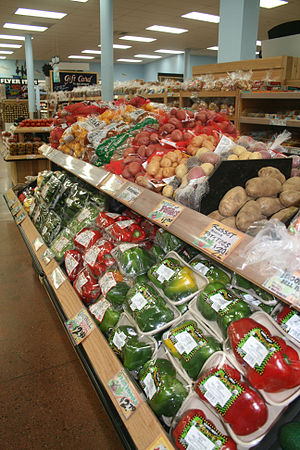Do you ever think of water traveling from country to country? What about food? A study that came out in 2012 measures how water is shipped around the world for human consumption, not in the form of bottled water but as food and other final products– water foot-printing, if you will, or virtual water.
As winter is upon us and we, in Colorado see more fruits and vegetables imported from warmer places. What better time to think about moving commodities, and water, from country to country and our connection to the global market? The U.S. is a net exporter of virtual water, but when it comes to Colorado, and agriculture specifically, it can be hard to define exactly how that market works. As we reported in the Fall 2012 issue of Headwaters Magazine, Colorado produce isn’t necessarily grown for Colorado households:
“It’s not Colorado farmers feeding Colorado households on some sort of one-to- one relationship. Colorado farmers grow for the world and Colorado consumers buy from the world. There’s no exclusivity.” National and local food sourcing, at least in traditional large grocery stores, shows up merely as a cost factor. When a grocery conglomerate can import tomatoes more reliably and at a lower cost than purchasing locally, they’ll import. But while produce is in season in Colorado grocery stores typically source locally because it’s inexpensive.
The same concept applies internationally— Colorado produces beef at a lower cost than Japan or Korea because of our vast farm and ranchland, says Larsen. “They put a 40 percent import duty on our beef, and we still are in the Japanese market for a price lower than the Japanese-produced beef.”
When it comes to international imports, Colorado is largely importing products that add to quality of life, Larsen says. We obtain a lot of our fresh produce in the winter by importing it along with other year-round commodities like seafood, coffee and liquor.
It’s more difficult to track interstate trade, but Pritchett and Graff are working on collecting that information so researchers, the public and the state all have a better understanding of those flows of goods and services. Graff is also working with Gov. John Hickenlooper’s administration on an economic development initiative called “Colorado Blueprint.” His studies will inform decision-making and help make agriculture a more intentional component of the state’s economic development effort.
We may not yet know exactly how those imports and exports are mapped when it comes to tracing Colorado’s water footprint, but how does water come into play? Researchers at Colorado State University have found that water for irrigation is key to much of the economic activity in Colorado’s rural communities. Others have found that water for agriculture in Colorado may have some incredible ancillary benefits like creating wetlands, which also can have a positive economic impact on the community. Read more to learn about water for agriculture in Colorado or share your thoughts and practices.
Does water footprinting matter to you? What about where your food is grown and produced? The value of water? The value of water for agriculture?


 Print
Print